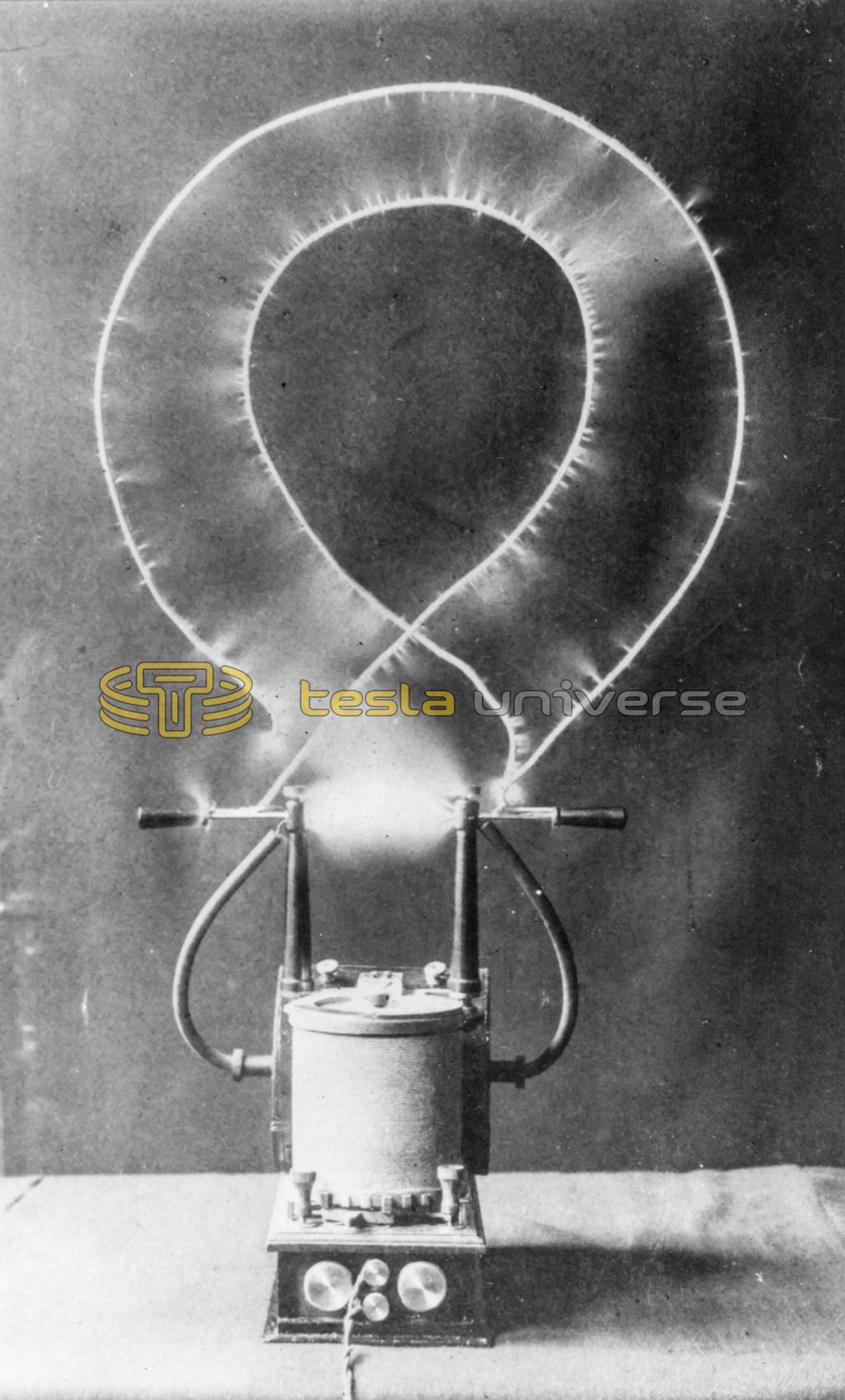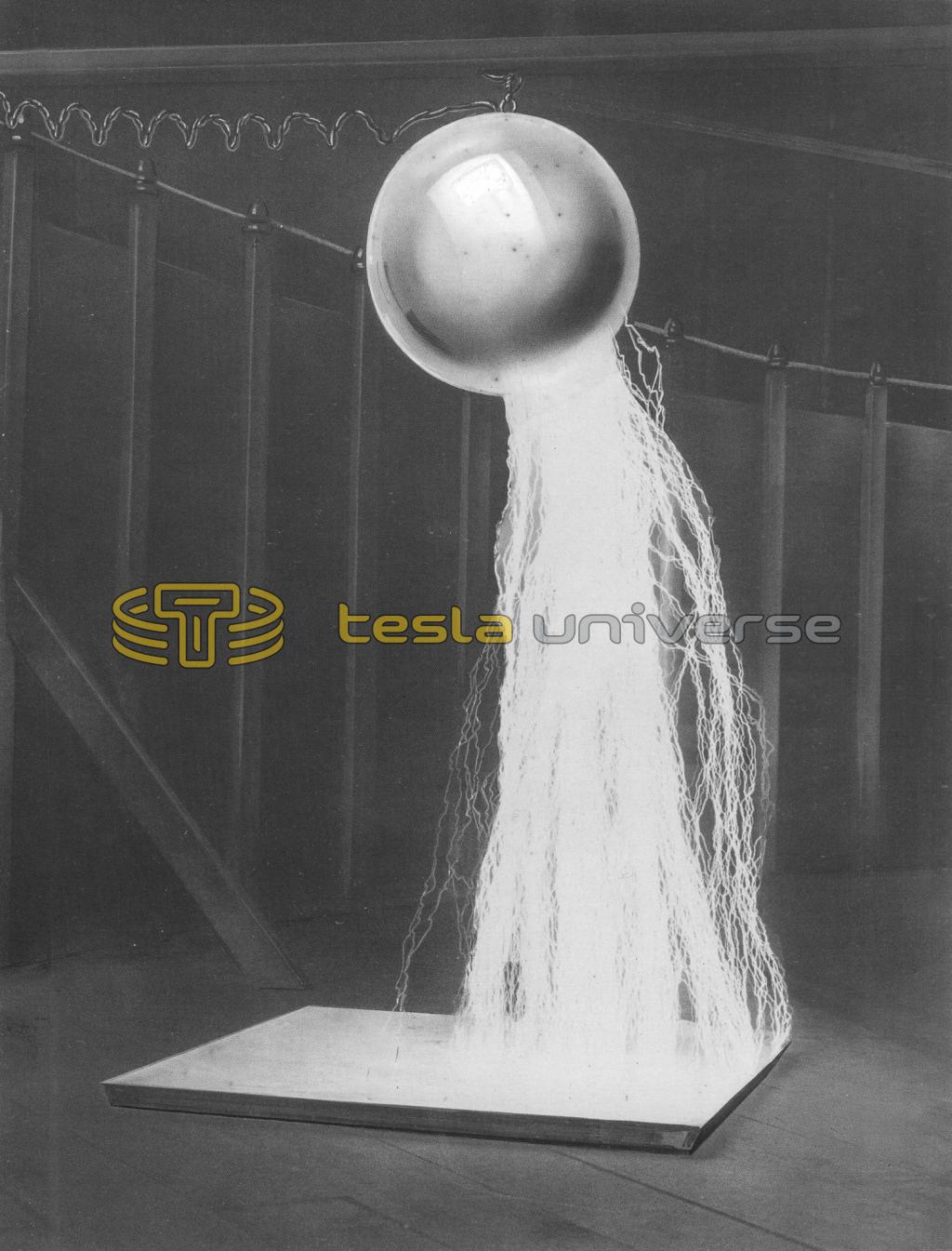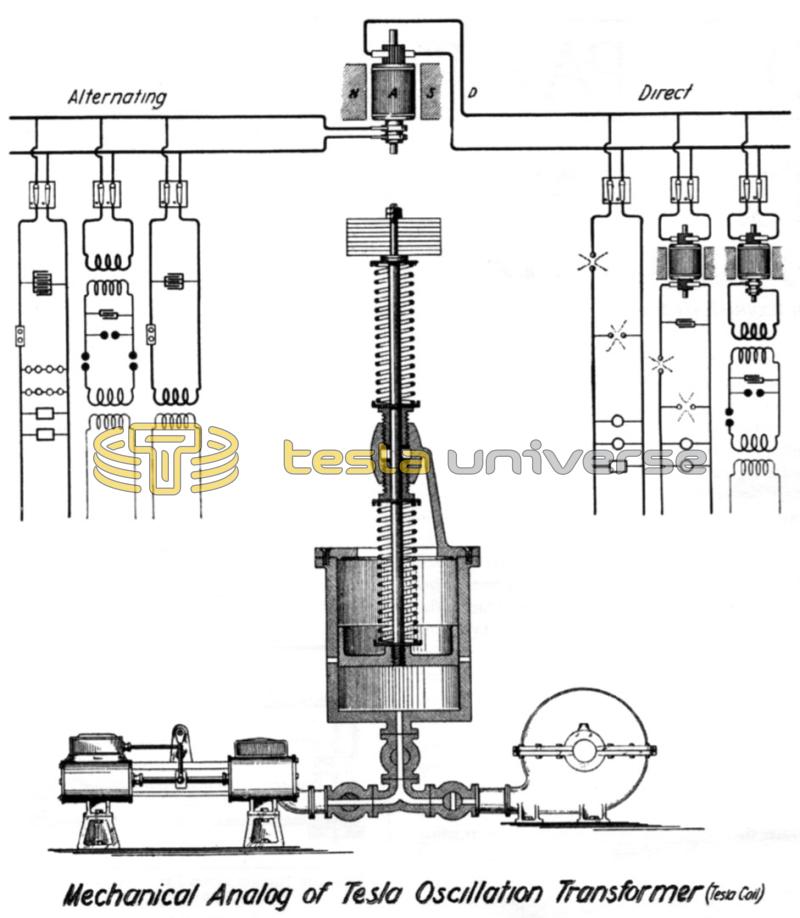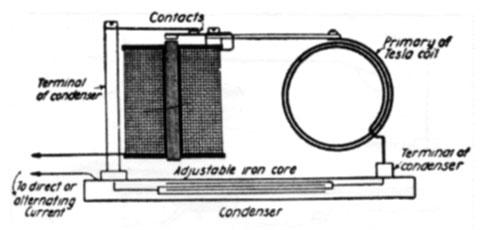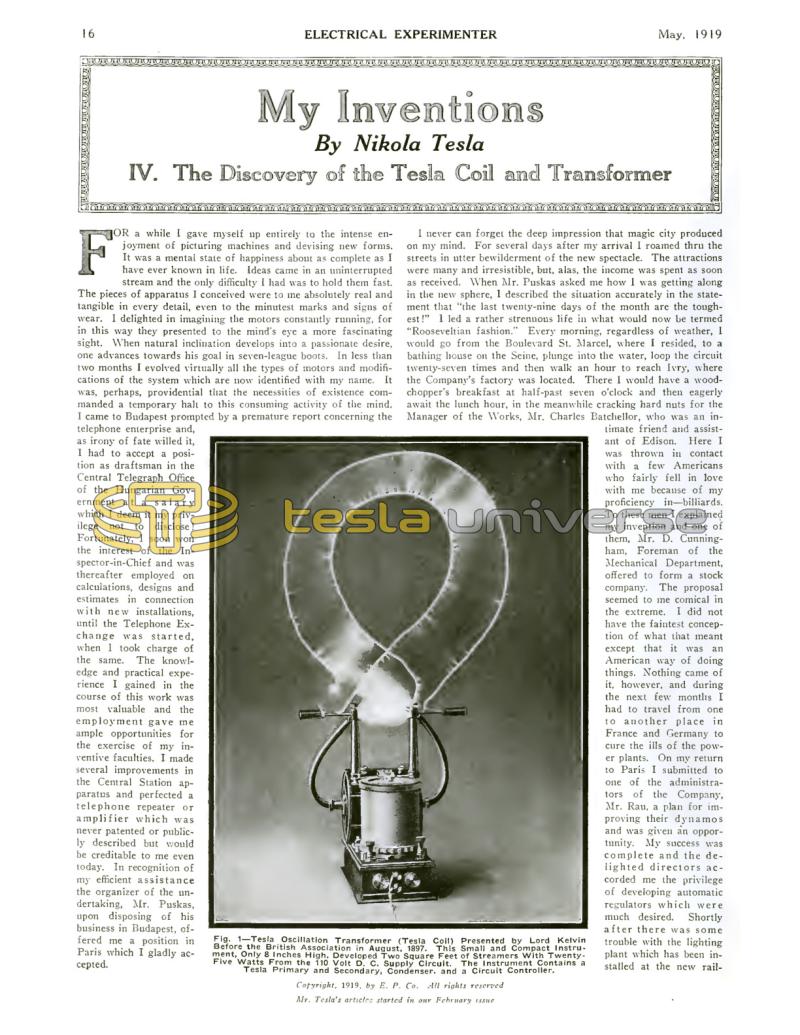
Nikola Tesla Articles
My Inventions IV - The Discovery of the Tesla Coil and Transformer
For a while I gave myself up entirely to the intense enjoyment of picturing machines and devising new forms. It was a mental state of happiness about as complete as I have ever known in life. Ideas came in an uninterrupted stream and the only difficulty I had was to hold them fast. The pieces of apparatus I conceived were to me absolutely real and tangible in every detail, even to the minute marks and signs of wear. I delighted in imagining the motors constantly running, for in this way they presented to mind's eye a more fascinating sight. When natural inclination develops into a passionate desire, one advances towards his goal in seven-league boots. In less than two months I evolved virtually all the types of motors and modifications of the system which are now identified with my name. It was, perhaps, providential that the necessities of existence commanded a temporary halt to this consuming activity of the mind. I came to Budapest prompted by a premature report concerning the telephone enterprise and, as irony of fate willed it, I had to accept a position as draftsman in the Central Telegraph Office of the Hungarian Government at a salary which I deem it my privilege not to disclose! Fortunately, I soon won the interest of the Inspector-in-Chief and was thereafter employed on calculations, designs and estimates in connection with new installations, until the Telephone Exchange was started, when I took charge of the same. The knowledge and practical experience I gained in the course of this work was most valuable and the employment gave me ample opportunities for the exercise of my inventive faculties. I made several improvements in the Central Station apparatus and perfected a telephone repeater or amplifier which was never patented or publicly described but would be creditable to me even today. In recognition of my efficient assistance the organizer of the undertaking, Mr. Puskas, upon disposing of his business in Budapest, offered me a position in Paris which I gladly accepted.
I never can forget the deep impression that magic city produced on my mind. For several days after my arrival I roamed thru the streets in utter bewilderment of the new spectacle. The attractions were many and irresistible, but, alas, the income was spent as soon as received. When Mr. Puskas asked me how I was getting along in the new sphere, I described the situation accurately in the statement that "the last twenty-nine days of the month are the toughest!" I led a rather strenuous life in what would now be termed "Rooseveltian fashion." Every morning, regardless of weather, I would go from the Boulevard St. Marcel, where I resided, to a bathing house on the Seine, plunge into the water, loop the circuit twenty-seven times and then walk an hour to reach Ivry, where the Company's factory was located. There I would have a woodchopper's breakfast at half-past seven o'clock and then eagerly await the lunch hour, in the meanwhile cracking hard nuts for the Manager of the Works, Mr. Charles Batchellor, who was an intimate friend and assistant of Edison. Here I was thrown in contact with a few Americans who fairly fell in love with me because of my proficiency in billiards. To these men I explained my invention and one of them, Mr. D. Cunningham, Foreman of the Mechanical Department, offered to form a stock company. The proposal seemed to me comical in the extreme. I did not have the faintest conception of what that meant except that it was an American way of doing things. Nothing came of it, however, and during the next few months I had to travel from one to another place in France and Germany to cure the ills of the power plants. On my return to Paris I submitted to one of the administrators of the Company, Mr. Rau, a plan for improving their dynamos and was given an opportunity. My success was complete and the delighted directors accorded me the privilege of developing automatic regulators which were much desired. Shortly after there was some trouble with the lighting plant which had been installed at the new railroad station in Strassburg, Alsace. The wiring was defective and on the occasion of the opening ceremonies a large part of a wall was blown out thru a short-circuit right in the presence of old Emperor William I. The German Government refused to take the plant and the French Company was facing a serious loss. On account of my knowledge of the German language and past experience, I was entrusted with the difficult task of straightening out matters and early in 1883 I went to Strassburg on that mission.
The First Induction Motor Is Built.
Some of the incidents in that city have left an indelible record on my memory. By a curious coincidence, a number of men who subsequently achieved fame, lived there about that time. In later life I used to say, "There were bacteria of greatness in that old town. Others caught the disease but I escaped!" The practical work, correspondence, and conferences with officials kept me preoccupied day and night, but, as soon as I was able to manage I undertook the construction of a simple motor in a mechanical shop opposite the railroad station, having brought with me from Paris some material for that purpose. The consummation of the experiment was, however, delayed until the summer of that year when I finally had the satisfaction of seeing rotation effected by alternating currents of different phase, and without sliding contacts or commutator, as I had conceived a year before. It was an exquisite pleasure but not to compare with the delirium of joy following the first revelation.
Among my new friends was the former Mayor of the city, Mr. Bauzin, whom I had already in a measure acquainted with this and other inventions of mine and whose support I endeavored to enlist. He was sincerely devoted to me and put my project before several wealthy persons but, to my mortification, found no response. He wanted to help me in every possible way and the approach of the first of July, 1919, happens to remind me of a form of "assistance" I received from that charming man, which was not financial but none the less appreciated. In 1870, when the Germans invaded the country, Mr. Bauzin had buried a good sized allotment of St. Estephe of 1801 and he came to the conclusion that he knew no worthier person than myself to consume that precious beverage. This, I may say, is one of the unforgettable incidents to which I have referred. My friend urged me to return to Paris as soon as possible and seek support there. This I was anxious to do but my work and negotiations were protracted owing to all sorts of petty obstacles I encountered so that at times the situation seemed hopeless.
THE proverbial trials and tribulations known to every inventor were not spared Tesla, the world's greatest inventor of all times. In this article we see him, arrived at young manhood, struggling along in a cold world. Already his fame has spread far and wide and his genius is recognized. But converting genius and fame into dollars and cents is quite a different matter, and the world is full of unappreciative and unscrupulous men. Tesla, the idealist, cared little for money and thus was promptly taken advantage of. But let Tesla himself tell you in his own inimitable style. It is a wonderful story.
In this month's installment Tesla also tells us how he made one of his most important as well as sensational discoveries--the Tesla Coil. Few inventions have caused such a sensation as this one which culminated in the only man-made lightning ever produced. The Tesla coil has so many uses and has been built in so many styles that it would take a catalog to list them all. From the spectacular high frequency stunts on the stage down to the "violet" ray machine in your home; all are Tesla coils in one form or another.
Wireless without the Tesla Coil would not be possible today. Without an oscillation transformer, spark gap and condenser--which is a Tesla Coil--the sending station would be crippled.
But it is for industrial purposes where the Tesla Coil will shine brightest in the future. The production of Ozone, the extraction of Nitrogen from the air in huge quantities--all are children of Tesla's fertile brain. His coil is the key to them all.
EDITOR
German "Efficiency".
Just to give an idea of German thoroness and "efficiency," I may mention here a rather funny experience. An incandescent lamp of 16 c.p. was to be placed in a hallway and upon selecting the proper location I ordered the monteur to run the wires. After working for a while he concluded that the engineer had to be consulted and this was done. The latter made several objections but ultimately agreed that the lamp should be placed two inches from the spot I had assigned, whereupon the work proceeded. Then the engineer became worried and told me that Inspector Averdeck should be notified. That important person called, investigated, debated, and decided that the lamp should be shifted back two inches, which was the place I had marked. It was not long, however, before Averdeck got cold feet himself and advised me that he had informed Ober-Inspector Hieronimus of the matter and that I should await his decision. It was several days before the Ober-Inspector was able to free himself of other pressing duties but at last he arrived and a two-hour debate followed, when he decided to move the lamp two inches farther. My hopes that this was the final act were shattered when the Ober-Inspector returned and said to me: "Regierungsrath Funke is so particular that I would not dare to give an order for placing this lamp without his explicit approval." Accordingly arrangements for a visit from that great man were made. We started cleaning up and polishing early in the morning. Everybody brushed up, I put on my gloves and when Funke came with his retinue he was ceremoniously received. After two hours' deliberation he suddenly exclaimed: "I must be going," and pointing to a place on the ceiling, he ordered me to put the lamp there. It was the exact spot which I had originally chosen,
So it went day after day with variations, but I was determined to achieve at whatever cost and in the end my efforts were rewarded. By the spring of 1884 all the differences were adjusted, the plant formally accepted, and I returned to Paris with pleasing anticipations. One of the administrators had promised me a liberal compensation in case I succeeded, as well as a fair consideration of the improvements I had made in their dynamos and I hoped to realize a substantial sum. There were three administrators whom I shall designate as A, B and C for convenience. When I called on A he told me that B had the say. This gentleman thought that only C could decide and the latter was quite sure that A alone had the power to act. After several laps of this circulus viciosus it dawned upon me that my reward was a castle in Spain. The utter failure of my attempts to raise capital for development was another disappointment and when Mr. Batchellor prest me to go to America with a view of redesigning the Edison machines, I determined to try my fortunes in the Land of Golden Promise. But the chance was nearly mist. I liquefied my modest assets, secured accommodations and found myself at the railroad station as the train was pulling out. At that moment I discovered that my money and tickets were gone. What to do was the question. Hercules had plenty of time to deliberate but I had to decide while running alongside the train with opposite feelings surging in my brain like condenser oscillations. Resolve, helped by dexterity, won out in the nick of time and upon passing thru the usual experiences, as trivial as unpleasant, I managed to embark for New York with the remnants of my belongings, some poems and articles I had written, and a package of calculations relating to solutions of an unsolvable integral and to my flying machine. During the voyage I sat most of the time at the stern of the ship watching for an opportunity to save somebody from a watery grave, without the slightest thought of danger. Later when I had absorbed some of the practical American sense I shivered at the recollection and marvelled at my former folly.
Tesla in America
I wish that I could put in words my first impressions of this country. In the Arabian Tales I read how genii transported people into a land of dreams to live thru delightful adventures. My case was just the reverse. The genii had carried me from a world of dreams into one of realities. What I had left was beautiful, artistic and fascinating in every way; what I saw here was machined, rough and unattractive. A burly policeman was twirling his stick which looked to me as big as a log. I approached him politely with the request to direct me. "Six blocks down, then to the left," he said, with murder in his eyes. "Is this America?" I asked myself in painful surprise. "It is a century behind Europe in civilization." When I went abroad in 1889 - five years having elapsed since my arrival here - I became convinced that it was more than one hundred years AHEAD of Europe and nothing has happened to this day to change my opinion.
Tesla Meets Edison
The meeting with Edison was a memorable event in my life. I was amazed at this wonderful man who, without early advantages and scientific training, had accomplished so much. I had studied a dozen languages, delved in literature and art, and had spent my best years in libraries reading all sorts of stuff that fell into my hands, from Newton's "Principia" to the novels of Paul de Kock, and felt that most of my life had been squandered. But it did not take long before I recognized that it was the best thing I could have done. Within a few weeks I had won Edison's confidence and it came about in this way.
The S.S. Oregon, the fastest passenger steamer at that time, had both of its lighting machines disabled and its sailing was delayed. As the superstructure had been built after their installation it was impossible to remove them from the hold. The predicament was a serious one and Edison was much annoyed. In the evening I took the necessary instruments with me and went aboard the vessel where I stayed for the night. The dynamos were in bad condition, having several short-circuits and breaks, but with the assistance of the crew I succeeded in putting them in good shape. At five o'clock in the morning, when passing along Fifth Avenue on my way to the shop, I met Edison with Batchellor and a few others as they were returning home to retire. "Here is our Parisian running around at night," he said. When I told him that I was coming from the Oregon and had repaired both machines, he looked at me in silence and walked away without another word. But when he had gone some distance I heard him remark: "Batchellor, this is a d-n good man," and from that time on I had full freedom in directing the work. For nearly a year my regular hours were from 10.30 A.M. until 5 o'clock the next morning without a day's exception. Edison said to me: "I have had many hard-working assistants but you take the cake." During this period I designed twenty-four different types of standard machines with short cores and of uniform pattern which replaced the old ones. The Manager had promised me fifty thousand dollars on the completion of this task but it turned out to be a practical joke. This gave me a painful shock and I resigned my position.
Immediately thereafter some people approached me with the proposal of forming an arc light company under my name, to which I agreed. Here finally was an opportunity to develop the motor, but when I broached the subject to my new associates they said: "No, we want the arc lamp. We don't care for this alternating current of yours." In 1886 my system of arc lighting was perfected and adopted for factory and municipal lighting, and I was free, but with no other possession than a beautifully engraved certificate of stock of hypothetical value. Then followed a period of struggle in the new medium for which I was not fitted, but the reward came in the end and in April, 1887, the Tesla Electric Company was organized, providing a laboratory and facilities. The motors I built there were exactly as I had imagined them. I made no attempt to improve the design, but merely reproduced the pictures as they appeared to my vision and the operation was always as I expected.
In the early part of 1888 an arrangement was made with the Westinghouse Company for the manufacture of the motors on a large scale. But great difficulties had still to be overcome. My system was based on the use of low frequency currents and the Westinghouse experts had adopted 133 cycles with the object of securing advantages in the transformation. They did not want to depart from their standard forms of apparatus and my efforts had to be concentrated upon adapting the motor to these conditions. Another necessity was to produce a motor capable of running efficiently at this frequency on two wires which was not easy of accomplishment.
At the close of 1889, however, my services in Pittsburg being no longer essential, I returned to New York and resumed experimental work in a laboratory on Grand Street, where I began immediately the design of high frequency machines. The problems of construction in this unexplored field were novel and quite peculiar and I encountered many difficulties. I rejected the inductor type, fearing that it might not yield perfect sine waves which were so important to resonant action. Had it not been for this I could have saved myself a great deal of labor. Another discouraging feature of the high frequency alternator seemed to be the inconstancy of speed which threatened to impose serious limitations to its use. I had already noted in my demonstrations before the American Institution of Electrical Engineers that several times the tune was lost, necessitating readjustment, and did not yet foresee, what I discovered long afterwards, a means of operating a machine of this kind at a speed constant to such a degree as not to vary more than a small fraction of one revolution between the extremes of load.
The Invention of the Tesla Coil
From many other considerations it appeared desirable to invent a simpler device for the production of electric oscillations. In 1856 Lord Kelvin had exposed the theory of the condenser discharge, but no practical application of that important knowledge was made. I saw the possibilities and undertook the development of induction apparatus on this principle. My progress was so rapid as to enable me to exhibit at my lecture in 1891 a coil giving sparks of five inches. On that occasion I frankly told the engineers of a defect involved in the transformation by the new method, namely, the loss in the spark gap. Subsequent investigation showed that no matter what medium is employed, be it air, hydrogen, mercury vapor, oil or a stream of electrons, the efficiency is the same. It is a law very much like that governing the conversion of mechanical energy. We may drop a weight from a certain height vertically down or carry it to the lower level along any devious path, it is immaterial insofar as the amount of work is concerned. Fortunately however, this drawback is not fatal as by proper proportioning of the resonant circuits an efficiency of 85 per cent is attainable. Since my early announcement of the invention it has come into universal use and wrought a revolution in many departments. But a still greater future awaits it. When in 1900 I obtained powerful discharges of 100 feet and flashed a current around the globe, I was reminded of the first tiny spark I observed in my Grand Street laboratory and was thrilled by sensations akin to those I felt when I discovered the rotating magnetic field.
